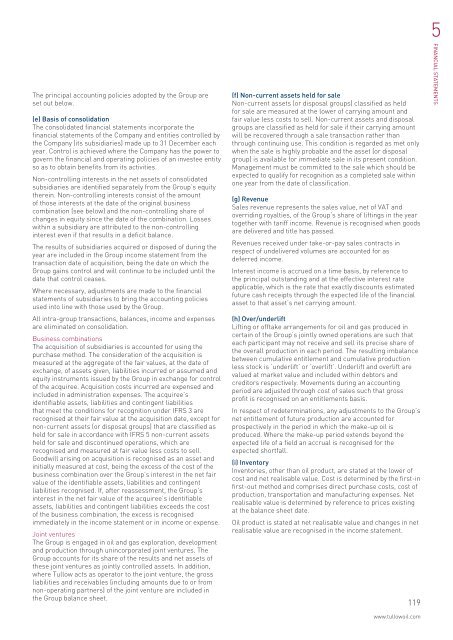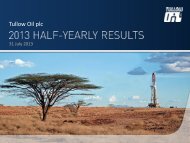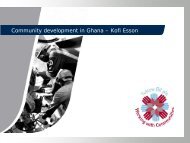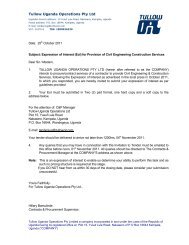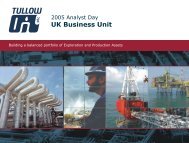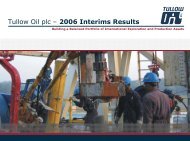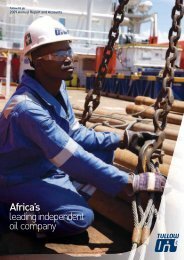2011 Annual Report PDF - Tullow Oil plc
2011 Annual Report PDF - Tullow Oil plc
2011 Annual Report PDF - Tullow Oil plc
Create successful ePaper yourself
Turn your PDF publications into a flip-book with our unique Google optimized e-Paper software.
The principal accounting policies adopted by the Group are<br />
set out below.<br />
(e) Basis of consolidation<br />
The consolidated financial statements incorporate the<br />
financial statements of the Company and entities controlled by<br />
the Company (its subsidiaries) made up to 31 December each<br />
year. Control is achieved where the Company has the power to<br />
govern the financial and operating policies of an investee entity<br />
so as to obtain benefits from its activities.<br />
Non-controlling interests in the net assets of consolidated<br />
subsidiaries are identified separately from the Group’s equity<br />
therein. Non-controlling interests consist of the amount<br />
of those interests at the date of the original business<br />
combination (see below) and the non-controlling share of<br />
changes in equity since the date of the combination. Losses<br />
within a subsidiary are attributed to the non-controlling<br />
interest even if that results in a deficit balance.<br />
The results of subsidiaries acquired or disposed of during the<br />
year are included in the Group income statement from the<br />
transaction date of acquisition, being the date on which the<br />
Group gains control and will continue to be included until the<br />
date that control ceases.<br />
Where necessary, adjustments are made to the financial<br />
statements of subsidiaries to bring the accounting policies<br />
used into line with those used by the Group.<br />
All intra-group transactions, balances, income and expenses<br />
are eliminated on consolidation.<br />
Business combinations<br />
The acquisition of subsidiaries is accounted for using the<br />
purchase method. The consideration of the acquisition is<br />
measured at the aggregate of the fair values, at the date of<br />
exchange, of assets given, liabilities incurred or assumed and<br />
equity instruments issued by the Group in exchange for control<br />
of the acquiree. Acquisition costs incurred are expensed and<br />
included in administration expenses. The acquiree’s<br />
identifiable assets, liabilities and contingent liabilities<br />
that meet the conditions for recognition under IFRS 3 are<br />
recognised at their fair value at the acquisition date, except for<br />
non-current assets (or disposal groups) that are classified as<br />
held for sale in accordance with IFRS 5 non-current assets<br />
held for sale and discontinued operations, which are<br />
recognised and measured at fair value less costs to sell.<br />
Goodwill arising on acquisition is recognised as an asset and<br />
initially measured at cost, being the excess of the cost of the<br />
business combination over the Group’s interest in the net fair<br />
value of the identifiable assets, liabilities and contingent<br />
liabilities recognised. If, after reassessment, the Group’s<br />
interest in the net fair value of the acquiree’s identifiable<br />
assets, liabilities and contingent liabilities exceeds the cost<br />
of the business combination, the excess is recognised<br />
immediately in the income statement or in income or expense.<br />
Joint ventures<br />
The Group is engaged in oil and gas exploration, development<br />
and production through unincorporated joint ventures. The<br />
Group accounts for its share of the results and net assets of<br />
these joint ventures as jointly controlled assets. In addition,<br />
where <strong>Tullow</strong> acts as operator to the joint venture, the gross<br />
liabilities and receivables (including amounts due to or from<br />
non-operating partners) of the joint venture are included in<br />
the Group balance sheet.<br />
(f) Non-current assets held for sale<br />
Non-current assets (or disposal groups) classified as held<br />
for sale are measured at the lower of carrying amount and<br />
fair value less costs to sell. Non-current assets and disposal<br />
groups are classified as held for sale if their carrying amount<br />
will be recovered through a sale transaction rather than<br />
through continuing use. This condition is regarded as met only<br />
when the sale is highly probable and the asset (or disposal<br />
group) is available for immediate sale in its present condition.<br />
Management must be committed to the sale which should be<br />
expected to qualify for recognition as a completed sale within<br />
one year from the date of classification.<br />
(g) Revenue<br />
Sales revenue represents the sales value, net of VAT and<br />
overriding royalties, of the Group’s share of liftings in the year<br />
together with tariff income. Revenue is recognised when goods<br />
are delivered and title has passed.<br />
Revenues received under take-or-pay sales contracts in<br />
respect of undelivered volumes are accounted for as<br />
deferred income.<br />
Interest income is accrued on a time basis, by reference to<br />
the principal outstanding and at the effective interest rate<br />
applicable, which is the rate that exactly discounts estimated<br />
future cash receipts through the expected life of the financial<br />
asset to that asset’s net carrying amount.<br />
(h) Over/underlift<br />
Lifting or offtake arrangements for oil and gas produced in<br />
certain of the Group’s jointly owned operations are such that<br />
each participant may not receive and sell its precise share of<br />
the overall production in each period. The resulting imbalance<br />
between cumulative entitlement and cumulative production<br />
less stock is ‘underlift’ or ‘overlift’. Underlift and overlift are<br />
valued at market value and included within debtors and<br />
creditors respectively. Movements during an accounting<br />
period are adjusted through cost of sales such that gross<br />
profit is recognised on an entitlements basis.<br />
In respect of redeterminations, any adjustments to the Group’s<br />
net entitlement of future production are accounted for<br />
prospectively in the period in which the make-up oil is<br />
produced. Where the make-up period extends beyond the<br />
expected life of a field an accrual is recognised for the<br />
expected shortfall.<br />
(i) Inventory<br />
Inventories, other than oil product, are stated at the lower of<br />
cost and net realisable value. Cost is determined by the first-in<br />
first-out method and comprises direct purchase costs, cost of<br />
production, transportation and manufacturing expenses. Net<br />
realisable value is determined by reference to prices existing<br />
at the balance sheet date.<br />
<strong>Oil</strong> product is stated at net realisable value and changes in net<br />
realisable value are recognised in the income statement.<br />
119<br />
www.tullowoil.com<br />
5<br />
FINANCIAL STATEMENTS


